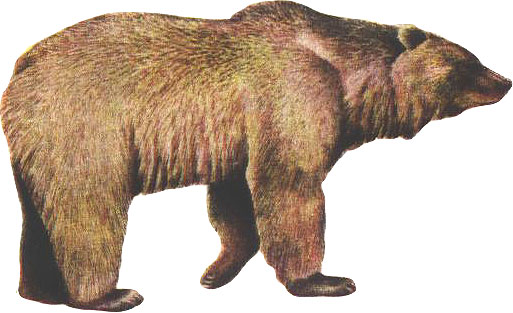|
|
The
Brown Bear: Ursus arctos
Its
heavier build and brown coat will suffice to distinguish it
from the Himalayan Black Bear. The brown varies individually
and seasonally from dark to light, while tips to the fur may
give the coat a silvery tinge. Usually the coat becomes tawny
or red brown when old and worn; a darker, richer brown when
grown new in summer, and long, luxuriant, and heavily furnished
with underwool before the onset of winter.

They are found in the higher levels of Waziristan, north western
and central Himalayas, and Butan.
The bare open peaks high above the tree line are the usual haunts
of these bears. Emerging from the winter sleep in the spring,
they follow the melting snows up to their perpetual level. At
this season and in the early summer they graze like cattle on
the newly grown grass, or hunting voles and marmots, which they
dig out of their burrows. It is the time when the food is not
plentiful and even carrions may be eaten. When summer has set
in individuals take to killing sheep and goats and ponies, which
are then brought to high pastures to graze. Developing this
habit a bear may become a real terror to livestock; but it never
becomes a man killer, fearing and avoiding man. Later in the
summer or early autumn the bear come down to the lower reaches.
It is the fruiting season when berries and the wild fruit are
to be had in the forests, apricots, peaches, apples, mulberries,
and walnuts. Brown Bear seldom climbs, and much of their diet
at this time is limited to grass, roots and tubers. But in winter,
there is no food and Bear goes into some shelter under the rocks,
in a cave or a den dug out by itself to pass the season. Females
are then with young, for they mate in the early summer, in May
or June. The cubs are born within the snug winter retreat. By
the May the cubs are sufficiently grown to follow their mother
in her quest for food. They remain with her till they attain
maturity. How long they really take to grow is not accurately
known.
Return
to Top
|


